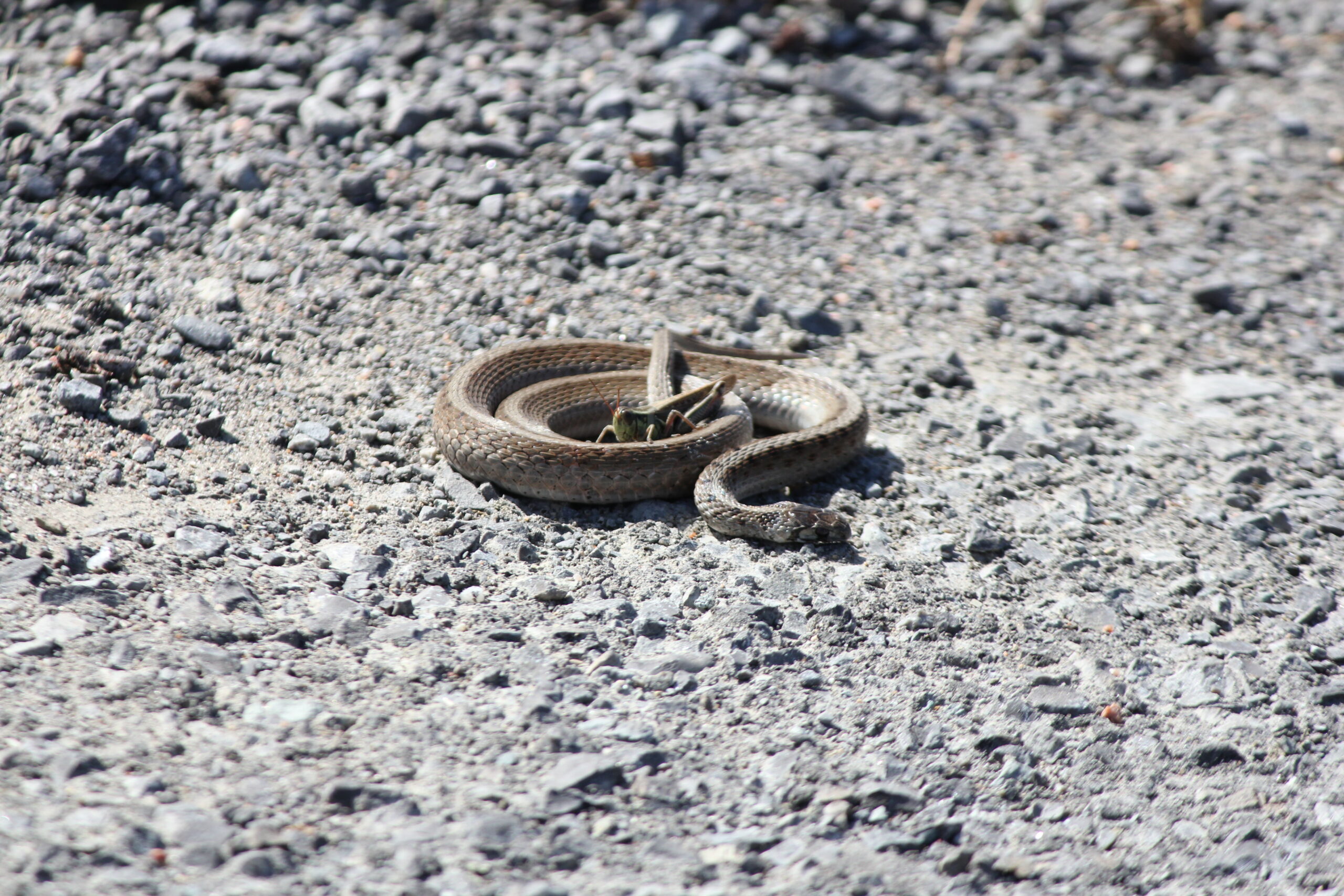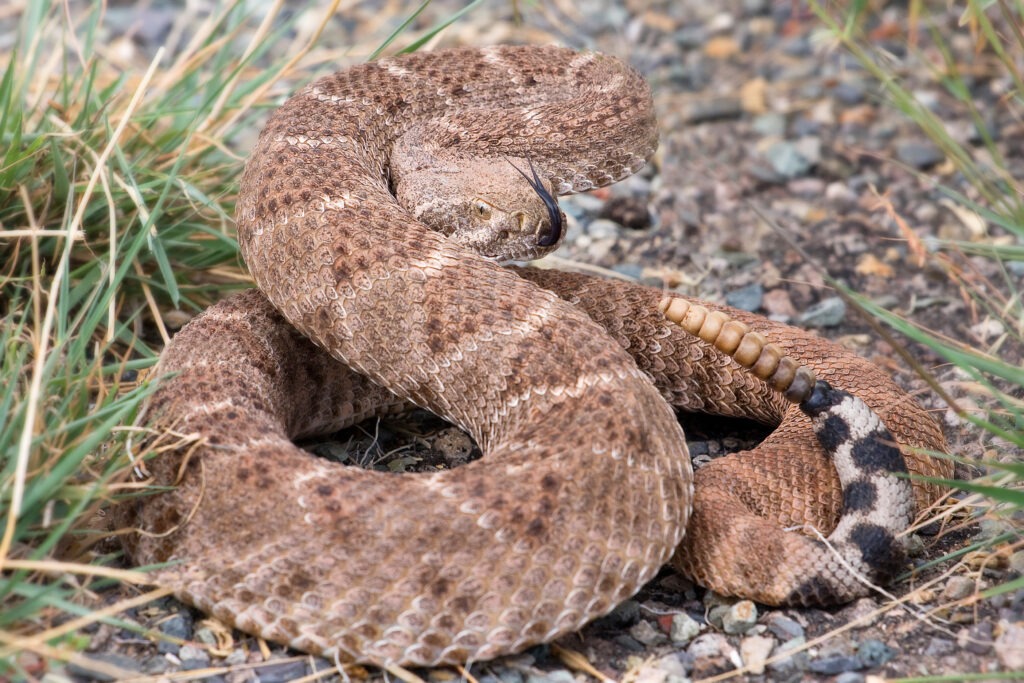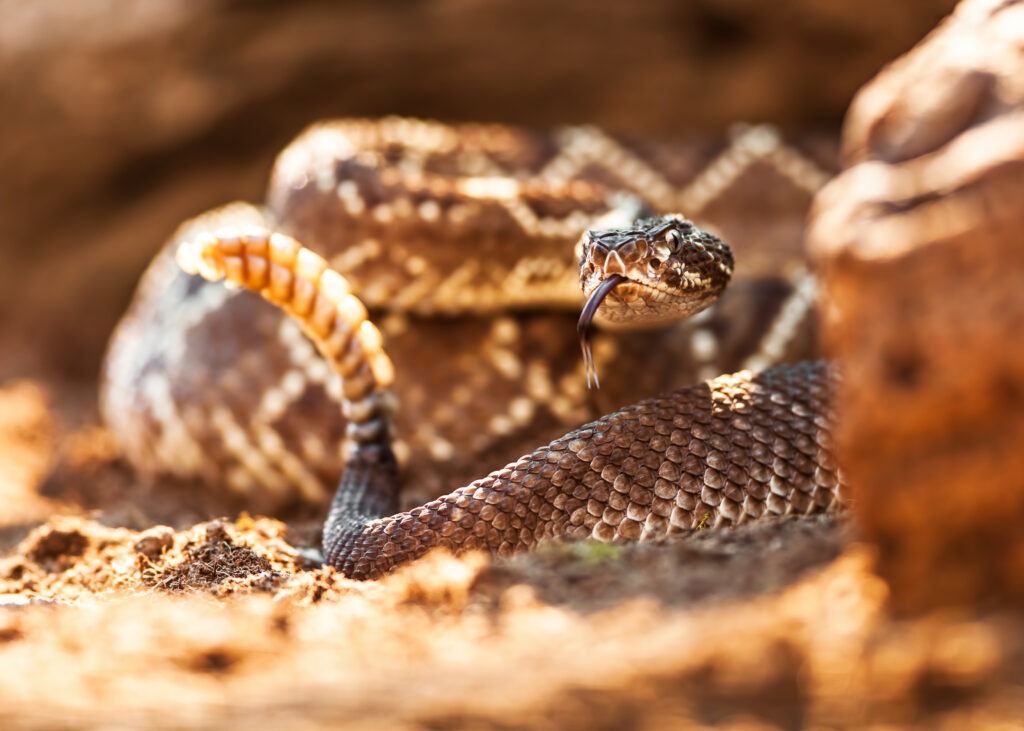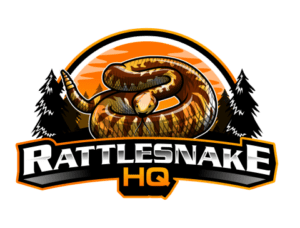
Rattlesnakes eat a wide variety of things from insects to small mammals. But when thinking about the ideal diet for a rattlesnake, I wondered do rattlesnakes eat grasshoppers?
Here’s what I’ve noticed:
Rattlesnakes are carnivores that eat grasshoppers and a variety of other insects. While they will eat grasshoppers and other large insects, they prefer birds and small mammals like mice, rats, squirrels, and rabbits. Sometimes, they also feed on other reptiles and frogs.
While it is true that rattlesnakes will eat grasshoppers, that is not their preferred source of food. They have a much bigger diet than just grasshoppers. Keep reading, and you can better understand their overall diet, from newborn to adult.
Feeding Habits of Rattlesnakes
Before we get into what rattlesnakes eat more often than grasshoppers, we should cover how they hunt and their eating habits. They have a specialized way of catching their food and interesting eating habits. Rattlesnakes are master hunters and it is worth understanding how they catch their prey.
Eating Habits
Rattlesnakes have very particular eating habits. For one, live prey is preferable to them. Rattlesnakes are not scavengers and will always hunt their prey and eat it live, or very soon after death. Like other snakes, rattlesnakes eat their prey whole and headfirst. It makes it much easier to swallow the limbs this way
Adult rattlesnakes feed about every 2 weeks, but they can go up to 2 years without eating if they need to!
Just like all snakes, it takes a long time for their food to digest because they swallow it whole. One small rabbit can keep an adult rattlesnake digesting for 3-5 days. After this digestion, the rattlesnake will be satiated for about the same amount of time.
Right after this time of digestion and satiation, they will begin looking for their next meal so they can catch it before they really need to.
Hunting
Rattlesnakes have a unique and really cool way of hunting their prey; they are ambush hunters. This means they lie in wait for their prey to come by and then they strike. They can strike at a distance of 1/3-1/2 of their body length.

Fangs:
Unlike some other snakes, rattlesnakes don’t struggle with the prey until it is dead but rather they incapacitate the small animal and then let them run away.
They do this because they use their fangs to inject the unsuspecting animal with venom. Rattlesnakes have huge, hinging fangs that can fold flat against their mouth.
They are hollow to allow the venom to pass through them and into their prey. Even outside of their venom, these snakes can do some serious damage to a small animal when they bite.
Venom:
Their venom is no joke as it is the first step in their digestive process.
The chemical composition of it quickly takes apart blood vessels and tissues soon after injection. The purpose of it is to cause pain, swelling, and necrosis that will stop the prey from moving, but not leave them dead. It is like the animal is being digested before it’s even eaten.
Heat Sensors:
Rattlesnakes are pit vipers, which means they have two pits between their nostrils and their eyes that can sense heat from other animals.
The snake will use these specialized heat-sensing pits to track the heat signature of the fleeing prey after injecting it with venom. Once found, the snake begins the process of swallowing it whole, head first, while the animal is still barely alive.
Adult Diet of Rattlesnakes
Specifically discussing the adult diet of a rattlesnake is important because the babies eat a bit differently and are worth discussing separately from the adults.
Mammals
Rattlesnakes love small mammals and these seem to be their preferred prey.
They will eat all kinds of mammals such as rats, mice, rabbits, gophers, and squirrels. Adult rattlesnakes are particularly partial to larger rodents as they will fill them up much better. Larger mammals include rabbits and squirrels, and it is quite the sight to see an adult rattlesnake swallow one whole.
Mammals are more commonly eaten by rattlesnakes because of their heat-sensing pit. Rattlesnakes can sense heat from warm-blooded mammals and hunt them much better than cold-blooded ones.
Because rattlesnakes are night hunters, they often prey on nocturnal mice and rats.
In the desert, many animals are smart enough to stay out of the nearly unbearable sun during the day, so both the predators and the prey come out at night to find food. Desert cottontails and antelope squirrels are out at night and often find themselves being hunted by rattlesnakes.
Birds
Birds are another commonly eaten kind of prey for a lot of animals, including rattlesnakes.
Small birds often fall prey to rattlesnakes, but surprisingly, larger birds are not necessarily safe from these cold-blooded hunters either. Smaller birds include quails and sparrows, while larger meals can include mockingbirds, meadowlarks, and even owls!
Rattlesnakes can use their heat sensors to track down birds easily. Birds are another easy animal for rattlesnakes to hunt as they have a slightly higher body temperature than mammals do. Rattlesnakes can use their heat sensors to track down birds easily.
While easy to track, birds are not so easy to catch as they move very quickly, sometimes faster than many of the small mammals we discussed. Unlike small mammals, birds can fly away and leave fewer traces for rattlesnakes to track down after delivering their venomous bite. Because of these things, birds tend to be eaten by rattlesnakes less frequently than small mammals.
Snakes
Believe it or not, rattlesnakes will also eat other snakes. This fact on its own may be unexpected, but it gets even crazier. Rattlesnakes will sometimes eat other rattlesnakes!
Right off the bat, it seems like it would be very difficult for rattlesnakes to hunt cold-blooded animals because of their heat-sensing organs. This is actually false. While it is more difficult than hunting warm-blooded mammals, hunting cold-blooded animals is not so difficult for a rattlesnake that it cannot be done.
Even cold-blooded animals produce at least a little heat, especially in their brains and eyes. While it is harder for rattlesnakes to sense such small areas of low heat, it is not impossible. If a rattlesnake needs to eat, it is going to hunt whatever is available and catch-able, including its own species.

Lizards and Frogs
In addition to snakes, other cold-blooded animals are consumed regularly by rattlesnakes. Lizards are a common meal for rattlesnakes as they are available in most habitats that these snakes live in. Whether it be a desert, forest, or swamp, there will be lizards for rattlesnakes to hunt.
Similar to the snakes that get eaten by rattlesnakes, a lizard’s cold blood does not protect it from a rattlesnake’s heat sensors. They are easy enough to catch and can be big or small for any size rattlesnake.
Frogs are an interesting food choice as they are more common in wetlands.
Though they are typically known for being desert predators, rattlesnakes can also live in swamps and are great swimmers! Frogs become a great source of food in places like these. Rabbits and squirrels might not be available in areas that are so wet, so the abundance of frogs is appealing to rattlesnakes.
Large Insects
Rattlesnakes are known to eat larger insects on occasion.
Though these insects, including grasshoppers, are not their preferred food, they will eat them if they are readily available and other kinds of food are in short supply.
Insects like grasshoppers are difficult to catch because of their small size, which does not provide much nutritional value or mass. They are not as appealing as other sources of food and are not worth the time they might take to catch. A rattlesnake also can’t use its “bite and hunt” technique because of how small insects are.
Grasshoppers are also diurnal, awake during the day, so they are not usually out when rattlesnakes are hunting.
Baby Rattlesnake Diet
Baby rattlesnakes are an interesting phenomenon because, after their first shed, they are ready to eat similar kinds of prey that adults do. Baby rattlesnakes are also perfectly capable of hunting their own food within a week of being born, though they can before then if need be.
Young rattlesnakes have venom after their first week of shedding. Contrary to popular belief, baby rattlesnakes do not inject more venom in a bite than adult rattlesnakes do. As they get older and bigger, rattlesnakes have larger venom glands and can store and release more venom when biting.
While adult rattlesnakes can go for two weeks comfortably without eating, baby rattlesnakes can only last one week without eating. Conveniently enough, that is how long it takes them to shed their first skin and begin hunting. Mother rattlesnakes help keep them warm and safe until they leave on their own after a week, but she has no way of feeding her young after they are born.
The only difference in the diet of baby rattlesnakes from adult rattlesnakes is that they hunt smaller food. They eat the same prey, just smaller versions of it. Their hunting skills come naturally so they are able to hunt whatever they can catch and whatever will fit in their mouths.
Lizards
Lizards are a great option for baby rattlesnakes as they can find small lizards to practice on. They are easy to catch and even some adult lizard species can be small enough for baby rattlesnakes. As mentioned before, lizards are prominent in every kind of habitat that rattlesnakes populate. This makes them a readily available meal for a growing rattlesnake.
Rodents
Small rodents make easy prey for baby rattlesnakes. Their size is an obvious benefit as they will fit into a baby’s mouth, but they are also easier to catch.
Small rodents mainly include young rodents who have not matured. They are easier to catch as they have not had much time to learn how to evade predators and keep themselves safe. They make an easy catch because of their heat signature being warmer than lizards. This makes it easier to track their bodies after the injected venom takes effect.
Insects
For the same reasons as the adults, baby rattlesnakes do not have a specific love for grasshoppers or other insects. While their size might seem appealing to this smaller snake, the problem of catching them comes up again.
For a young rattlesnake that’s learning to properly hunt, grasshoppers present quite the challenge because of how fast they move and how hard it is to strike one.
They are difficult to track with their heat-sensing organs and present too many challenges to be worth the time. When a rattlesnake develops their hunting technique, it is hard to catch things that do not allow them to use it.

Why Rattlesnakes eat Grasshoppers
While we have discussed why grasshoppers are not preferred by rattlesnakes, there are instances when a rattlesnake would eat one.
- Lack of better food – If a rattlesnake has not been able to find food for longer than their two-week rest period after eating, they might find themselves munching on a grasshopper. When you are a very hungry ambush predator, you will strike at anything that moves. While lying in wait for a bird or mouse, a grasshopper could travel past the snake’s waiting spot and be quickly targeted and eaten.
- If there are a lot of them – If grasshoppers are very prominent where rattlesnakes are hunting, they can become easy prey for a rattlesnake. While we have discussed how difficult it can be to catch a grasshopper, this can be made less difficult by an abundance of them. When there is a large population of grasshoppers, it is easier to catch one because if the snake misses one, there are more nearby to go for.
- They are easy to track – Grasshoppers might not emit a heat signature to track, but like other insects, they emit a hum that rattlesnakes can hear and track. This makes them a little easier to find than some other animals. However, the appeal of such a small meal is not very great, so a particularly hungry rattlesnake might not even bother trying to follow the sound.
